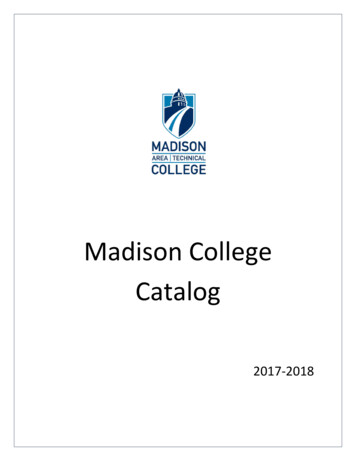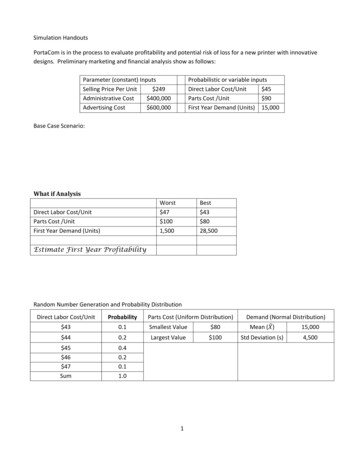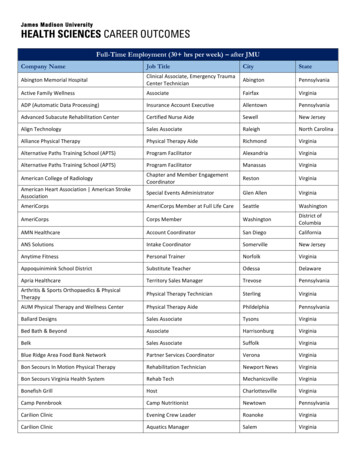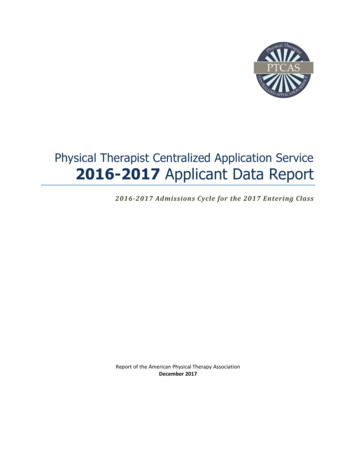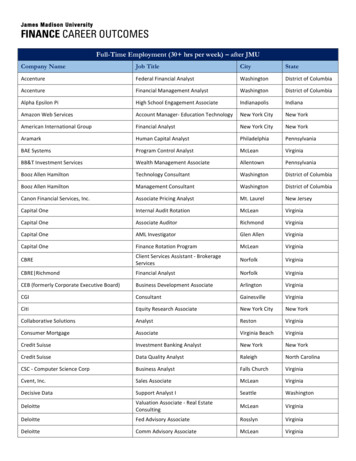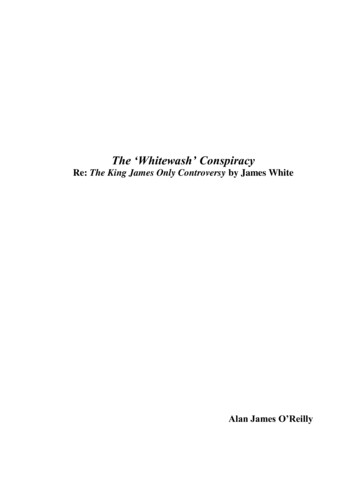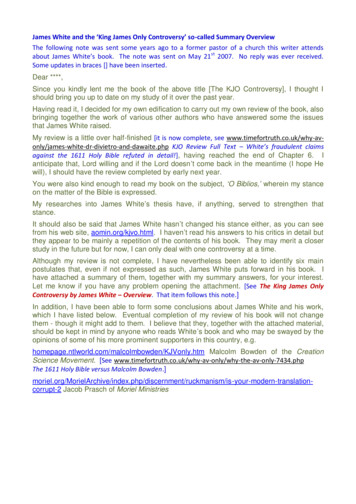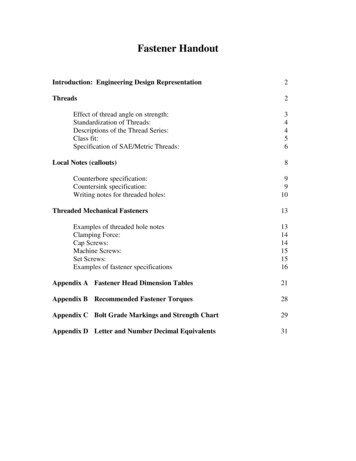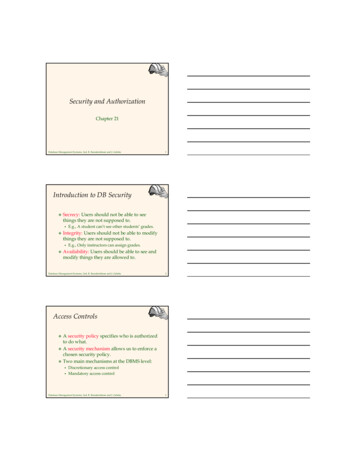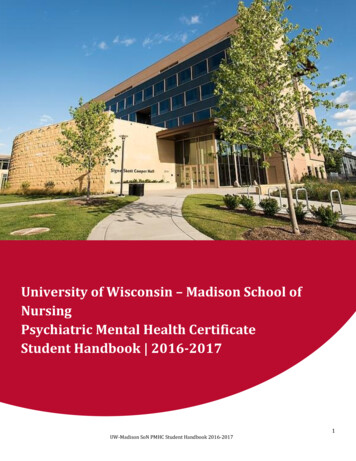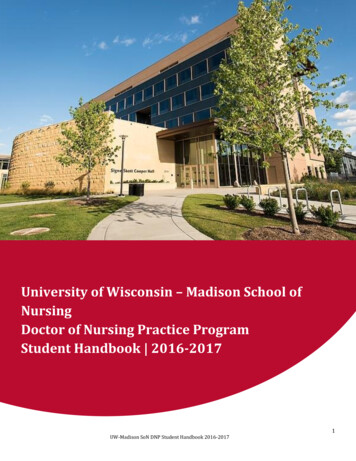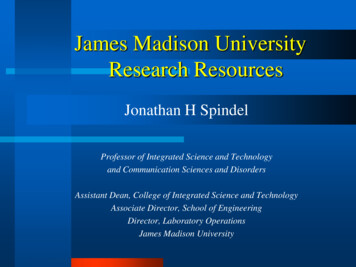
Transcription
James Madison UniversityResearch ResourcesJonathan H SpindelProfessor of Integrated Science and Technologyand Communication Sciences and DisordersAssistant Dean, College of Integrated Science and TechnologyAssociate Director, School of EngineeringDirector, Laboratory OperationsJames Madison University
Institutional Philosophy Educational mission is top priority Grants are primary funding vehicle Interdisciplinary collaboration across:–––––college departmentsuniversity collegesuniversity divisionswithin the communitythroughout the state
Core Support No university level administration CISAT and the School of Engineering throughCISAT/SOE Laboratory Operations CSM managed on a departmental level with somedegree of inter-departmental cooperation Personnel: a mix of state and grant funding Equipment: grant purchased, “new” building funds,department operation funds, and ETF as available
Examples of Collaborative Lab Environments Biomanufacturing Labs Microfabrication Cleanroom Shenandoah Valley Regional NMR Facility Product Realization Lab Advanced Fluid Flow Visualization Lab Alternative Fuels Vehicle Lab Science on a Sphere Edith J. Carrier Arboretum Energy Lab
Biomanufacturing Labs Research and development of genetically engineered cells,small-scale production of living cells, purification of recombinantproteins, and analytical analysis of product molecules– Collaboration across departments, colleges, and in collaborationwith SRI International (Harrisonburg, VA) Cross-college departments and disciplines involved:––––– Integrated Science and icsUniversity contact: Dr. Bob McKown, mckownrl@jmu.edu
Biomanufacturing Labs
Microfabrication Cleanroom A cleanroom facility housing equipment for the fabrication andcharacterization of thin film materials, microelectronic devices,micromechanical devices, and sensors. Processes investigated in this laboratory include thin film metaland dielectric deposition, etching, photolithography (patterning),and semiconductor doping. Cross-college departments and disciplines involved:–––– �StatisticsEngineeringMaterials ScienceIntegrated Science and TechnologyUniversity Contact: Dr. David Lawrence, lawrendj@jmu.edu
Microfabrication Cleanroom
Shenandoah Valley Regional NMR Facility The Shenandoah Valley Regional NMR Facility was establishedwith grants from The National Science Foundation, The MerckFoundation and matching funds provided by James MadisonUniversity, Eastern Mennonite University and Bridgewater College. The facility includes a Bruker Avance DRX-400 NMR, a BrukerAMX-200 NMR, and a 300 MHz Bruker DPX system. Cross-college departments and disciplines involved:– Chemistry– Biochemistry– Physics – Engineering– EMU– Bridgewater CollegeUniversity Contact: Tom Gallagher, gallahtn@jmu.edu
Shenandoah Valley Regional NMR Facility
Product Realization Lab Center for High Performance Manufacturing– A state-of-the-art manufacturing facility that provides high qualityprototype models, in order to develop solutions to meet specificneeds from design to production, providing metal (steel) and plastic(nylon) prototypes and limited-run plastic part manufacturing Cross-college departments and disciplines involved:– Integrated Science and Technology– Geographic Science– Art – Engineering– Business– BiotechnologyUniversity Contact: Mr. Dwight Dart, dartdr@jmu.edu
Product Realization Lab
Advanced Thermo Fluids Lab An advanced experimental fluid mechanics laboratory forstudying the broad range of applications includingcardiovascular, aerodynamic, and hydrodynamic flow. Cross-college departments and disciplines involved:– Integrated Science and Technology– Engineering– Physics – Physics– Biology– BiotechnologyUniversity Contact: Dr. Olga Pierrakos (SOE), pierraox@jmu.eduDr. Karim Altaii (ISAT), altaikx@jmu.eduDr. Heather Watson, watsonhl@jmu.edu
Advanced Thermo Fluids LabWind TunnelHeart SimulatorParticle ImageVelocimetrySystemWater Tunnel
Alternative Fuel Vehicle Lab Collaborative lab involving CISAT, CSM, SOE and JMU FacilitiesManagement that provides opportunities for ISAT students to studyadvanced transportation technologies and gain hands-onexperience in building, converting and adapting vehicles that runon renewable and alternative fuels Cross-college departments and disciplines involved:–––– Mechanical EngineeringElectrical EngineeringMaterial ScienceIntegrated Science and U Facilities ManagementUniversity Contact: Dr. Chris Bachmann, bachmacg@jmu.edu
Alternative Fuel Vehicle Lab
Science on a Sphere A facility that permits the researcher the opportunity topresent Earth from an astronaut’s perspective in space. The conventional objective of SOS is an educational tool toexpose the audience to issues and fundamentals ofscience. Accordingly, SOS comes with dozens of “movies”and images depicting environmental processes of Earth, suchas global climate effects and changes in land formations. Cross-college departments and disciplines involved:– Meteorology– Environmental Science– Earth Sciences University Contact: sphere@jmu.edu
Edith J. Carrier Arboretum The Arboretum provides an ideal combination of botanicalgardens and natural forest, each complementing the other andserving the purpose of research, teaching and demonstration.The complex serves as an outdoor biology laboratory as well asan environmental center for this region.Cross-college departments and disciplines involved:– Biology– Kinesiology– Geographic Information Systems – Education– Art– MusicUniversity Contact: Jan Mahon, mahonjs@jmu.edu
Edith J. Carrier ArboretumFrances Plecker Education Center
Energy Lab Devoted to upper level "hands-on" experiences and seniorproject work for students studying energy.The lab is used to study both conventional and alternative(solar and wind) energy production, as well as methods forimproving the energy efficiency of heating, ventilation and airconditioning equipment.Disciplines Utilized:– Integrated Science and Technology– Engineering– Physics University Contact: Dr. Tony Chen, chendt@jmu.edu
Energy Lab
Biosciences Building (2012)A new 90,000-SF academic building to housebiological science departments.In addition to classroom and teaching laboratories, the buildingincludes faculty offices, tutorial rooms for student-student andstudent-faculty collaboration, lecture rooms, computer labs,seminar rooms, common spaces for informal gathering, study,etc., and related support spaces. The program also includes ananimal care facility and research greenhouse.
Biosciences Building (2012)
ContactsJonathan Spindel (spindejh@jmu.edu)Assistant Dean, College of Integrated Science and TechnologyAssociate Director, School of EngineeringDirector, Laboratory OperationsJohn Noftsinger (noftsijb@jmu.edu)Vice Provost for Research and Public ServiceKen Newbold (newbolkf@jmu.edu)Director of Research DevelopmentBen Delp (delpbt@jmu.edu)Associate Director of Research Development
Core Support No university level administration CISAT and the School of Engineering through CISAT/SOE Laboratory Operations CSM managed on a departmental level with some degree of inter-departmental cooperation Personnel: a mix of state and grant funding Equipment: grant purchased, “new” building funds,
